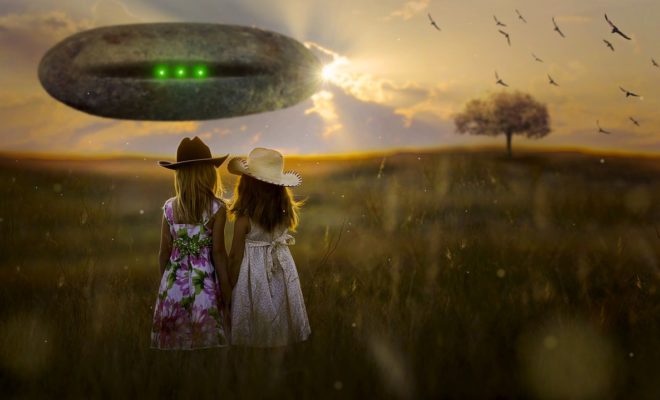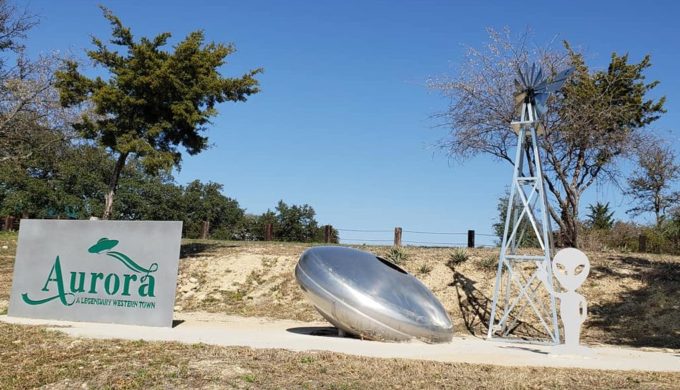When you hear the phrase “UFO crash,” you probably think of Roswell, New Mexico in 1947, but did you know that 50 years earlier, a mysterious airship allegedly crashed in Aurora, Texas? Not only that, but The Dallas Morning News claimed that the airship pilot, who was killed in the crash, was “not an inhabitant of this world.” The body of the pilot was buried in the local cemetery. You might dismiss it all as a Texas-size tall tale, but in the 1970s, reporter Jim Marrs managed to track down and interview a living eyewitness to the Aurora airship. Was this little Texas town, located about 20 miles northwest of Dallas, the site of an other-worldly encounter?
Between 1896 and 1897, dozens of reports of strange, cigar-shaped airships were reportedly witnessed across the country. The sightings began in California and headed east. The most dramatic of all these reports appeared in the April 17, 1897 edition of The Dallas Morning News. An article by Aurora resident S. E. Haydon claimed that near dawn two days earlier, an airship crashed into Judge J. S. Proctor’s windmill in Aurora.
Photo: Facebook/Eric Shirey
“…the early risers of Aurora were astonished at the sudden appearance of the airship which had been sailing throughout the country,” Haydon wrote. “Evidently some of the machinery was out of order, for it was making a speed of only ten or twelve miles an hour and gradually settling toward the earth. It sailed over the public square and when it reached the north part of town collided with Judge Proctor’s windmill and went to pieces with a terrific explosion, scattering debris over several acres of ground, wrecking the windmill and water tank and destroying the judge’s flower garden.” Haydon wrote of the corpse: “…while his remains are badly disfigured enough of the original has been picked up to show that he was not an inhabitant of this world.”
Papers written in a strange form of hieroglyphics were discovered on the body. According to Haydon, the ship was “built of an unknown metal, resembling somewhat a mixture of aluminum and silver, and it must have weighed several tons.” People from Aurora and the surrounding countryside gathered to view the debris, and a funeral for the dead pilot was held the next day.
Photo: Facebook: Aurora Texas
The similarities between the Aurora crash and modern UFO cases are difficult to dismiss as mere coincidence. Largely forgotten for decades, the Aurora case came into the public eye in the 1970s. In 1973, reporter Jim Marrs interviewed 83-year-old Charlie C. Stephens, who was at first reluctant to “get involved.” After some “neighborly conversation,” Marrs finally persuaded Stephens to reveal what he saw as a 10-year-old boy that April morning in 1897. That morning Charlie and his dad were working with cattle when they spotted the cigar-shaped craft passing low overhead with a bright light. They watched it move toward Aurora, then heard an explosion. Fire shone in the northern sky. “I wanted to go immediately and see what happened,” Stephens told Marrs, “but my daddy said we had to finish our chores.” The following day, Stephens’ father rode into town and viewed the airship debris.
Jim Marrs visited the Aurora Cemetery in 1973 and saw what was believed to be the pilot’s grave, marked by a “crude rock headstone” that was half-broken. On the remaining half, a design was etched that resembled “one end of a saucer-shaped structure” with small circles that appeared to be portholes. The grave itself wasn’t full-size but appeared to belong to either a child or a very small person. Fellow journalist Bill Case had used a metal detector over the grave and believed it contained “at least three large pieces of metal.” Later, Case returned to the grave site with his metal detector and discovered that the signal was gone. A metal pipe had been inserted into the ground—someone had apparently removed the metal pieces from the grave.
Photo: Facebook/Helmi Flick
In the 1970s, the grave marker was stolen, and the exact location of the pilot’s grave was lost. In recent years, Ground-penetrating radar has been used to discover an unmarked grave in the area where the pilot was believed to have been buried. Nonetheless, the Aurora Cemetery Association has been steadfast in its refusal to grant researchers the right to exhume the grave.
Was the pilot of the airship an alien, an interdimensional visitor, a badly-burned human, or just a belated April Fool’s prank? In 2004, Michael Busby published his extremely well-researched nonfiction book “Solving the 1897 Airship Mystery.” Busby’s book proposed that, rather than ETs, humans were behind the great airship sightings of 1897. The book examines theories about a secret society of airship builders, based in California in the 19th century, known as the “Sonora Aero Club.” The existence of this aero club only came to light when strange, beautiful drawings of airships were discovered in a Houston antique store in the 1960s. The story of Charles August Albert Dellschau, the artist who drew these airships and who claimed to have been a member of the aero club, is a fascinating tale in itself.
Whether you believe the Aurora airship was a tall tale or a compelling case of a real-life UFO crash, one thing is for sure: the Lone Star State is the home of legends that are larger than life.





